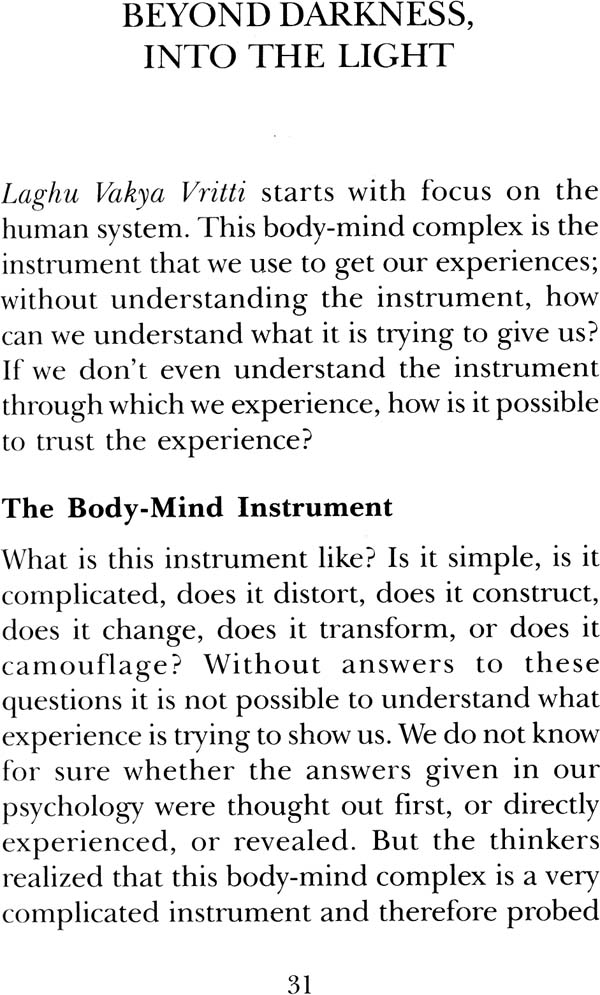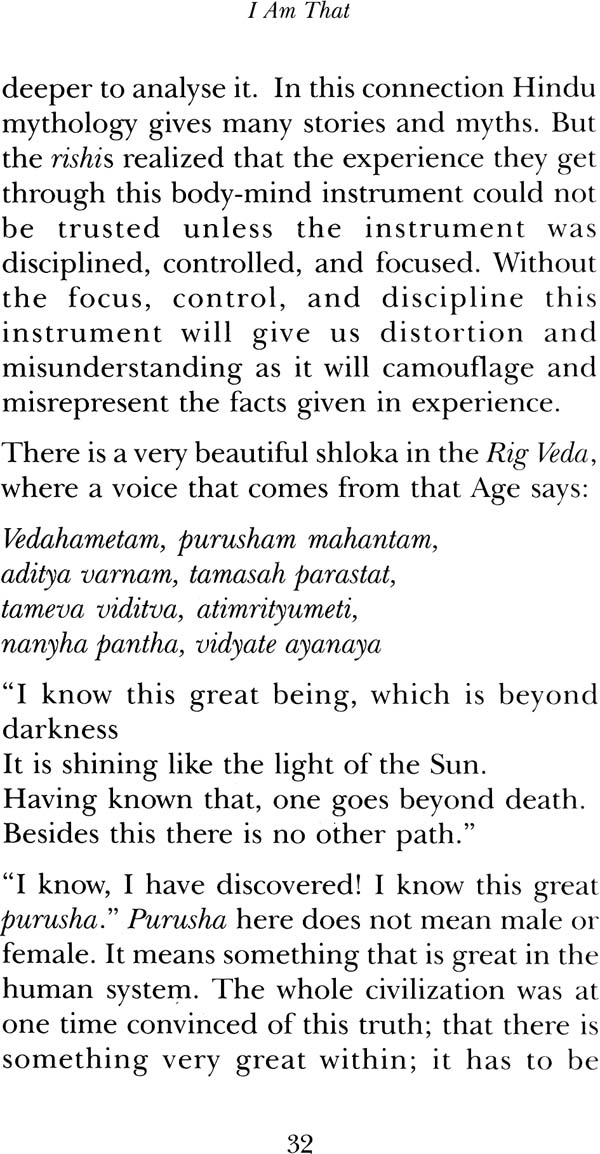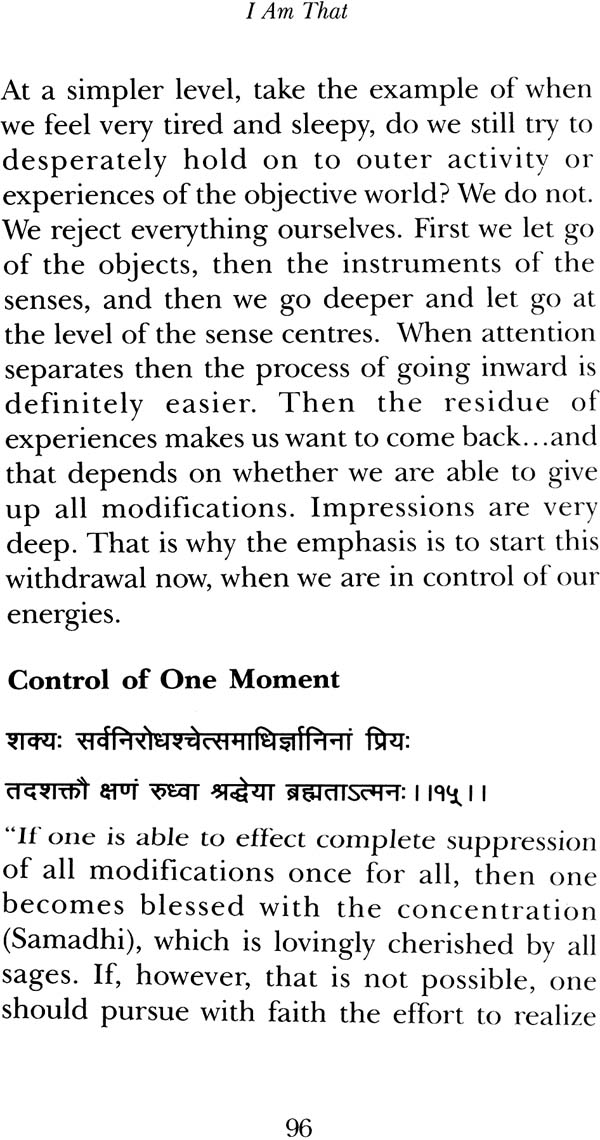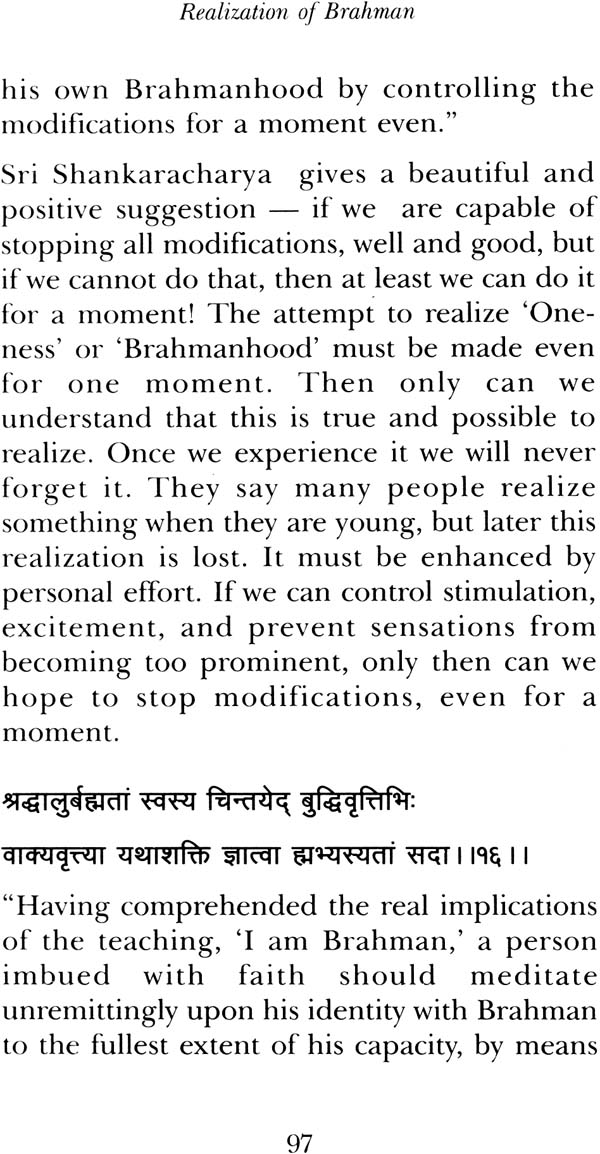
I Am That : The Joy of Inner Awareness - Based on Shri Shankaracharya's Laghu Vakya Vritti
Book Specification
| Item Code: | NAE779 |
| Author: | Pravrajika Vivekaprana |
| Publisher: | Angus and Grapher Publishers Pvt. Ltd |
| Language: | English |
| Edition: | 2011 |
| ISBN: | 9789380254036 |
| Pages: | 125 |
| Cover: | Paperback |
| Other Details | 7.0 inch x 4.5 inch |
| Weight | 130 gm |
Book Description
Pravrajika Vivekaprana, is a senior pravrajika (or sannyasini) of the Sri Sarada Math and the Ramakrishna Sarada Mission Order. She is presently in charge of the Retreat Centre of the Ramakrishna Sarada Mission at Pangot, district Nainital.
Pravrajika Vivekaprana has been following closely in the footsteps of Swami Vivekananda for 55 years. She has done art in-depth study of Hindu Philosophy in the context of human psychology. Her ability to reach out to her audiences always leaves a lasting impression.
She has travelled widely. Between 1989 and 2005 she went on lecture tours to Europe, England, South America and the United States of America, sharing her thoughts and understanding with a very wide range of listeners, both in terms of age and culture, In 1993, Pravrajika Vivekaprana spoke at the Parliament of Religions in Chicago; exactly 100 years after Swami Vivekananda spoke at the same forum in 1893.
After the retreats at Uruguay and the USA in 2005, Pravrajika Vivekaprana has been conducting regular retreats at the Retreat Centre at Pangot, and in Delhi and Mumbai. The Understanding Vedanta Lecture Series is the outcome of these retreats.
Continuing with the thoughts discussed in Books 4 and 5, Pravrajika Vivekaprana shares her in-depth understanding of the profound message of Sri Shankaracharya’s Laghu Vekya Vritti.
Before we start on the book, Laghu Vakya Vritti, et us recapitulate the background to the ancient Hindu scriptures and thought. The Rig Veda is the most ancient book known to mankind. This was followed by other Vedas. The Vedas have two portions: the jnana kanda, the knowledge portion as given in the Upanishads, and the karma kanda, the ceremonial portion. The Upanishads are the more concise and they give the principles. There was a time when the rishis could explain the deep hidden implications as given in these concepts.
Later, because the explanations were not forthcoming, people lost touch with the understanding of the principles given in the jnana kanda. This is the state we are in even today. That is when the second portion, the karma kanda, which emphasizes doing certain actions or rituals to achieve personal and social goals, became more powerful and popular then this happened there was a reaction from a few rare people, who protested and said, that was not the ultimate meaning and purpose. Among these people were the Buddha and Mahavira. Then came a time when the ancient thinkers started elucidating the implications. That was the time when the commentaries were written, arid they are all supposedly coming from Veda Vyasa.
Next comes the historical period where scholars wrote the six darshanas — the six types of philosophy that are trying to explain the same thing from different points of view. The ackaryas — Sri Shankaracharya, Sri Ramanujacharya, Sri Madhvacharya, Sri Nimbarkacharya, and Sri Vallabhacharya, built huge systems showing practical ways of worship and knowledge. They followed in the footsteps of Buddhism and jainism, which had already given many scholars to this civilization. They either pointed to the knowledge portion which emphasizes, “understand and become free” or the aspect of “worship and be free”. Strangely enough, we seem to care little about the concept of freedom. Because it is so subtle we do not think chat we really do seek freedom and meaning. The truth is that the human mind does not seek action or money for its own sake; everything is in the quest for freedom.
The Commentaries
In mediaeval India anyone who wanted to be recognized as an acharya had to write commentaries on the eight primary Upanishads, the Bhagavad Gita, and the Brahma Sutras. These scriptures are the basis of all that there is in Hindu philosophy. They had to write the commentaries and show through logical arguments that what they were saying was the meaning of these ancient books.
Sri Ramanujacharya gave Vishishta Advaita; Sri Shankaracharya gave Advaita; although Sri Vallabhacharya followed the path of “Shuddha Advaita”, he is known as a bhakti preacher in Vaishnavism Sri Nimbarkacharya propagated the Dvaitadvaita philosophy of dualistic monism; and Sri Madhvacharya was the chief proponent of Dvaita. Because of demonstrators such as, Godai or Andal in the South and Meera Bai in the North, Chaitanya Mahaprabhu, Surdas, Tulsidas and many others, who rose from Dvaita to Vishishta Advaita and then to Advaita, the ideas became prevalent or popular everywhere. Almost everyone is aware of the three points of view though without a clear understanding of where they come from and how they can be connected. The Bhagavad Gita has connected the three points of vie but because it is a very ancient scripture the modern reader is not too clear about it.
A Short Exposition of Vedic Sentences
Laghu Vakya Vritti was written by Sri Shankaracharya, in the 8th century. Whenever I read such treatises, I marvel that 1200 years ago we had a culture where they emphasized these concepts that are so crucial to human life. Today, we are not even aware of these ideas; or maybe we don’t think that there is any relevant answer in them. In Laghu Vakya Vritti, Sri Shankaracharya is trying to give us the roots to these practical concepts. Not a single Hindu scripture or any concept that we consider our heritage is merely theoretical. Hindu psychology and philosophy start with trying to understand life, finding the Truth, and discovering the way out. Today we remain unaware that we have got concepts in our own background, which are the main guidelines to understand our lives.
| Editors Note | VII | |
| 1 | Introduction | 1 |
| 2 | Beyond Darkness in to the Light | 31 |
| 3 | Consciousness is the light | 55 |
| 4 | Control of Modification and finding the gap | 73 |
| 5 | Realization of Brahman | 92 |









